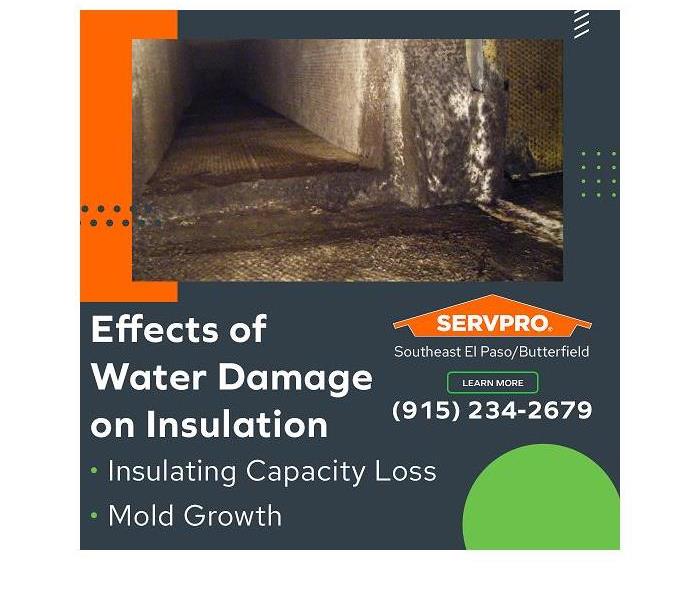SERVPRO explains the impact of water on a home’s insulation
5/3/2022 (Permalink)
Blog Summary: Water damage is a significant risk in all homes. SERVPRO explains how water can affect your home's insulation and what you should do in such a situation.
Several factors can lead to insulation leakage, from a pipe burst to a build-up of moisture. Most homeowners want to know whether water damage can affect their insulation and its ability to work properly.
So the water restoration professionals at SERVPRO of Southeast El Paso/Butterfield explained the effects of water damage on insulation and what you can do if your insulation is affected by water.
Effects of Water Damage on insulation
Insulating Capacity Loss
The main purpose of the insulation is to reduce the transfer of heat between the inside and outside of the house. This ability to resist the conductive flow of heat is measured by the R-value of all insulation. The higher the R-value any insulation has, the more insulating power it generates.
Water damage can cause a significant reduction in R-value, resulting in markedly cooler or higher temperatures within the property, depending on the season. Although fiberglass insulation is technically watertight, the batt surrounding it might become wet and reduce the R-value.
Mold Growth
Mold can be a concern in your home. Fiberglass is meant to trap dust and mold in the air. However, when it is exposed to moisture, mold can start growing on the paper backing of fiberglass insulation.
Additionally, cellulose insulation is treated using fire-retardants which are mold-resistant compounds. Mold spores, on the other hand, can absorb water through the cellulose.
When the cellulose becomes wet, it can absorb moisture and transport it to drywall, ceilings, and timber structures. This can result in mold spreading throughout your attic, causing rot.
Different Wet Insulation Types
Insulations react to water differently. Some are unaffected, while others need to be dried out to avoid mold growth. Here are some common water-damaged insulation types you can be faced with.
1. Wet Cellulose Insulation
If you notice loose and gray fibers around the floor and wall cavities, it means you have cellulose insulation. Celluloses are plant-based products that are made majorly with recycled newspaper, and as such it’s quite difficult to recover once damaged by water.
But you can remove the wet insulation, allow it to dry for a couple of days, and then when properly dried, replace it. However, if you have a more severe leak, the moisture may have soaked a larger part of the insulation, which can cause mold to start growing around that spot within days, requiring complete removal and replacement.
2. Wet Spray Foam Insulation
If your floor and wall cavities are wholly filled with hard white foam, your property has spray foam insulation. Even though spray foam acts as a moisture barrier and forms an airtight seal, the leak is still a concern since water can harm the wood around the insulation. To protect your home's porous materials from moisture damage, find the hole and close it.
3. Wet fiberglass insulation
If you find pink baths or notice that your insulation is loose-fill insulation, then your home was insulated with fiberglass. And since it’s made from glass strands, it doesn’t absorb water. But when the air gaps between the fibers are filled with moisture, the insulation's capacity to inhibit heat transfer is compromised. Wet fiberglass insulation is about as effective as no insulation at all since water is a conductor.
How to Prevent Insulation Water Damage
- Keep an eye on your roof for leaks, which may wreak havoc on your attic insulation.
- Check your siding for holes. Holes can let moisture in and damage the insulation on your external walls.
- Keep moisture out of your basement insulation by sealing your foundation and basement walls.
Get Professional Water Damage Insulation Services
Schedule immediate cleanup as soon as you notice water-damaged insulation. SERVPRO of Southeast El Paso/Butterfield is the name you can trust when it comes to insulation restoration in the Southeast El Paso and Butterfield area. They offer a wide range of services, from water damage restoration to fire repair, storm damage cleanup, mold removal, and more.
SERVPRO of Southeast El Paso/Butterfield has a team of professionals available 24/7 and is committed to cleaning your home and handling any form of damage.
They are your first choice whenever you have a wet insulation situation.
Contact SERVPRO of Southeast El Paso/Butterfield at (915) 234-2679 to speak to a professional.




 24/7 Emergency Service
24/7 Emergency Service
